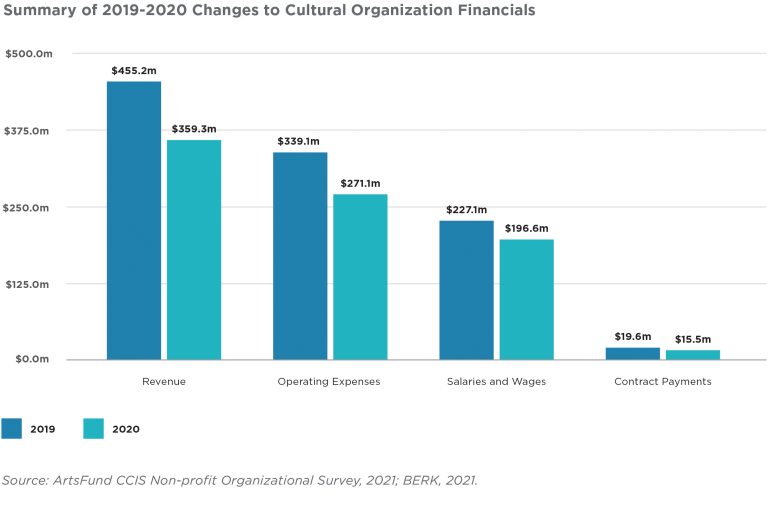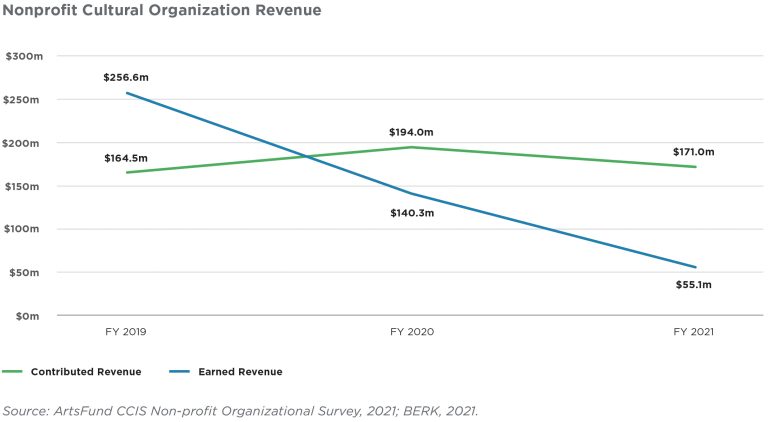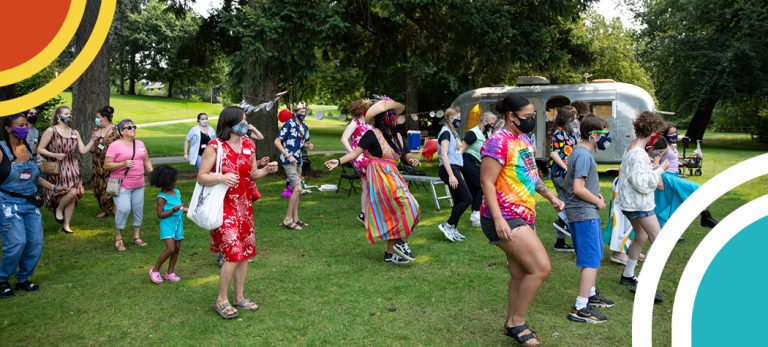
COVID Cultural Impact Study
Charting the state of Washington's cultural nonprofits
We are not at the tail-end of a pandemic – we are at the beginning of a structural transformation.
Together we can reimagine the role of arts and culture in our communities. The COVID Cultural Impact Study (CCIS) documents and analyzes the pandemic’s impacts on Washington’s cultural community, including nonprofit producers and presenters of art and culture, the workforce, and the public who participate in these cultural activities.
The study uses several data sources: a Nonprofit Organizational Survey with 212 survey respondents from arts, cultural, heritage, and science nonprofit organizations from across the state; a Cultural Participant Survey of 737 adults who had attended at least one cultural program since March 2020, and a Statewide Omnibus Poll which was a sample of 874 individuals representative of all Washington residents. The study began in the Spring of 2021 and concluded data collection in early Fall of 2021.
Utilizing data from both cultural organizations and Washington residents, the COVID Cultural Impact Study (CCIS) analyzes the depth of the challenges the pandemic has created for Washington’s art and culture sector and illuminates the support necessary to revitalize these integral institutions.
To download the full report, please provide the following information.
"*" indicates required fields
Jump to a section:
Findings
The COVID Cultural Impact Study underscores how critical arts and culture organizations are to Washington’s continued economic and community recovery and highlights the pivotal opportunity to transform how Washington invests in the future. Key findings include:
FINANCIAL IMPACT: Across 121 reporting organizations, there was a $95.9 million (21 percent) decrease in overall revenue and $68.5 million (20 percent) reduction in operating budgets in 2020 alone.
The $95.9 million loss in overall revenue is comprised of a $131.6 million decrease in earned revenue (e.g., ticket sales) and a $35.7 million increase in contributed revenue (e.g., individual donations, grants). Without the increase in critical funding from the public sector, individuals, philanthropy and other actors, the cultural sector would have experienced loss at a much greater scale.

EMPLOYMENT: The cultural workforce has been significantly impacted, prompting concern for a “cultural brain drain.” Nearly half (41 percent) of organizations furloughed staff or reduced hours and/or pay.
REOPENING: While over 70 percent of cultural organizations are open in some capacity, public participation declined significantly during COVID and the constantly changing nature of the pandemic means many have not returned to in-person events. Cultural participants are expected to spend about half of what they spent pre-pandemic on cultural programming,
impacting related industries including food, lodging, and retail, among others.
THE FUTURE: Cultural participants resoundingly agree (93 percent) that the role of art and cultural organizations will be important to Washington’s post-pandemic recovery. Half (48 percent) of cultural participants have placed more value on cultural programming since March 2020.
The top 5 roles cultural participants felt cultural non-profits should play are:
“Economic recovery for businesses and organizations”,
“Encouraging community unity and vitality”,
“Providing entertainment and escape”,
“Offering inspiration and hope”, and
“Creating employment for individuals.”
Future Outlook & Opportunities
The pandemic has indisputably changed us forever, and many of the longer-term impacts have yet to fully reveal themselves. Though limited, our survey data shows that organizations are far from recovery and running out of options. We used the data to scan the horizon for opportunities and two themes emerged. First, we consider how cultural organizations may continue to evolve over the coming years and the opportunities to support them in that transformation. Second, we look at the role cultural organizations can and will play in our collective social and economic future and wellbeing. It is evident that funders and policymakers also have some critical evolution ahead if they are to keep pace with the needs of the sector and communities.
Total revenues across organizations with three years of data declined by 14% between FY 2019 and 2020 and declined again by 26% between FY 2020 and 2021. Earned revenue declined by 42% between FY 2019 and 2020 and again by another 51% between FY 2020 and 2021.

Recommendations
ArtsFund’s recommendations focus on five key areas highlighted for government and policy makers, cultural organizations, private funders, corporations and corporate funders, individual participants, and partner sectors.
Reimagine the role of arts and culture: center the cultural sector in economic development strategies, encourage cross-sector partnerships, and generate new audience research.
Expand and sustain public support: advocate for legislations that provide sustainable funding for the cultural sector and directly invest in arts as a strategy for social impact.
Protect the cultural workforce: pilot models to increase cultural worker wages and wage stability, expand employment definitions and eligibility criteria, invest in services to make arts occupations more viable, and create avenues to share resources and learnings across organizations.
Focus on equity: actively eliminate funding barriers, engage youth and families, learn from and better serve disability communities, and help diminish the digital divide.
Support adaptation and survival: provide unrestricted, multi-year support, further access to technology, support public health initiatives, and participate and give!

Case Studies
The CCIS includes five case studies from a range of organizations that illustrate the nuance behind the numbers of the pandemic experience. Selections were made to include different perspectives based on geography, the organizations’ BIPOC identity, discipline, and the scale of the organization. Qualitative interviews with representatives from each organization were conducted in October and November 2021.
LANGSTON, Multidisciplinary, King County
LANGSTON’s mission is to strengthen and advance our community through Black arts and culture.
Seattle Art Museum Visual Arts, King County
Seattle Art Museum’s mission is to connect art to life.
Spark Central Arts Service Organization, Spokane County
Spark Central is a 501 (c) 3 nonprofit that ignites the creativity, innovation, and imagination necessary for people to forge the path to their best future.
Tasveer Film/Literary Arts, King County
Tasveer is a social justice arts non-profit with a mission to inspire social change through thought-provoking South Asian films, art, and storytelling.
TeenTix Arts Service Organization, Multidisciplinary, Youth Service Organization, King County
TeenTix builds a bright future for our region by empowering young people to take an active role in shaping their arts community as audience members, critics, influencers, advocates, patrons, and leaders.
Additional Resources
Media Coverage
A Fuller Picture of COVID’s Impact on the Arts
425 Business, April 5, 2022
Washington’s arts and culture sector lost nearly $100M when COVID-19 pandemic hit
The Spokesman-Review, January 28, 2022
Struggling Art Sector is Critical to State’s Recovery, Report Shows
South Seattle Emerald, January 25, 2022
ArtSEA: Seattle orgs are learning the art of bouncing back
Crosscut, January 20, 2022
BIPOC-Led Cultural Organizations Got Tons of Funding in 2020—Then We Left Them High and Dry
The Stranger, January 20, 2022
Non-profit sponsors study on how the pandemic impacted arts and culture in Puget Sound
Seattle Weekly, January 20, 2022
Save the arts & cultural industry to help build a future through pandemic
KNDO/NBC Right Now, January 20, 2022
Here’s how badly the pandemic hurt Washington arts — and some ways the sector can recover
Seattle Times, January 19, 2022
‘Come on home’: Washington arts groups seek community’s help in COVID comeback
King5, January 19, 2022
New audiences, less money. How local arts orgs are doing now
KUOW, January 19, 2022
Local art, performance venues lose nearly $100M due to COVID
KOIN, January 19, 2022
New study highlights devastating effect pandemic has had on Washington arts
MyNorthwest, January 19, 2022
New study shows how COVID-19 changed art and culture in Washington
KXLY, January 19, 2022
Advisory Committee
Kate Becker, Office of King County Executive Dow Constantine
Jane Broom, Microsoft Philanthropies
Mason Burley, Innovia Foundation
Amy Chasanov, The 5th Avenue Theatre
Jennifer Chastain, formerly Bank of America
David Fischer, Tacoma Arts Live
Melissa Huggins, Spokane Arts
Jason Hunke, Vulcan Inc.
Keri Kellerman: Scandiuzzi Krebs; formerly Whim W’Him
Elizabeth MacPherson, Mithun; ArtsFund Board of Trustees
James Miles, MENTOR Washington
Markham McIntyre, Seattle Metropolitan Chamber of Commerce
Joan Rabinowitz, Jack Straw Cultural Center
Julia Reed, Kinetic West
Nina Yarbrough, 4Culture; formerly Central District Forum for Arts & Ideas
Sponsors
The COVID Cultural Impact Study report is sponsored by:
![]()
With additional support from:
![]()

Report authored by:
![]()
Research collaboration by:

Dr. William B. Beyers,
University of Washington
Design by:
![]()
CCIS Community Conversations sponsor:
![]()
Photo Credits
Museum of Pop Culture (MoPOP), Girl Scout Day at the Museum, photo courtesy of MoPOP
Seattle Art Museum, Seattle Asian Art Museum Reopening performance, photo by Jueqian Fang
Tacoma Arts Live, Caravan Chronicles, photo by Lisa Monet Photography